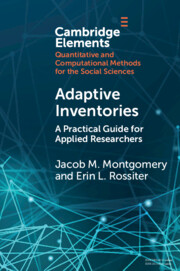14 results

Adaptive Inventories
- A Practical Guide for Applied Researchers
-
- Published online:
- 08 July 2022
- Print publication:
- 28 July 2022
-
- Element
- Export citation
Polls, Context, and Time: A Dynamic Hierarchical Bayesian Forecasting Model for US Senate Elections
-
- Journal:
- Political Analysis / Volume 31 / Issue 1 / January 2023
- Published online by Cambridge University Press:
- 18 January 2022, pp. 113-133
-
- Article
- Export citation
Topics, Concepts, and Measurement: A Crowdsourced Procedure for Validating Topics as Measures
-
- Journal:
- Political Analysis / Volume 30 / Issue 4 / October 2022
- Published online by Cambridge University Press:
- 27 September 2021, pp. 570-589
-
- Article
- Export citation
The Effects of Unsubstantiated Claims of Voter Fraud on Confidence in Elections
-
- Journal:
- Journal of Experimental Political Science / Volume 10 / Issue 1 / Spring 2023
- Published online by Cambridge University Press:
- 28 June 2021, pp. 34-49
-
- Article
-
- You have access
- Open access
- HTML
- Export citation
Bayesian Versus Maximum Likelihood Estimation of Treatment Effects in Bivariate Probit Instrumental Variable Models
-
- Journal:
- Political Science Research and Methods / Volume 7 / Issue 3 / July 2019
- Published online by Cambridge University Press:
- 23 April 2018, pp. 651-659
-
- Article
- Export citation
A Pairwise Comparison Framework for Fast, Flexible, and Reliable Human Coding of Political Texts
-
- Journal:
- American Political Science Review / Volume 111 / Issue 4 / November 2017
- Published online by Cambridge University Press:
- 05 September 2017, pp. 835-843
- Print publication:
- November 2017
-
- Article
- Export citation
An Informed Forensics Approach to Detecting Vote Irregularities
-
- Journal:
- Political Analysis / Volume 23 / Issue 4 / Autumn 2015
- Published online by Cambridge University Press:
- 04 January 2017, pp. 488-505
-
- Article
- Export citation
Bayesian Model Averaging: Theoretical Developments and Practical Applications
-
- Journal:
- Political Analysis / Volume 18 / Issue 2 / Spring 2010
- Published online by Cambridge University Press:
- 04 January 2017, pp. 245-270
-
- Article
- Export citation
Computerized Adaptive Testing for Public Opinion Surveys
-
- Journal:
- Political Analysis / Volume 21 / Issue 2 / Spring 2013
- Published online by Cambridge University Press:
- 04 January 2017, pp. 172-192
-
- Article
-
- You have access
- Export citation
Improving Predictions using Ensemble Bayesian Model Averaging
-
- Journal:
- Political Analysis / Volume 20 / Issue 3 / Summer 2012
- Published online by Cambridge University Press:
- 04 January 2017, pp. 271-291
-
- Article
-
- You have access
- Export citation
Polarization and Ideology: Partisan Sources of Low Dimensionality in Scaled Roll Call Analyses
-
- Journal:
- Political Analysis / Volume 22 / Issue 4 / Autumn 2014
- Published online by Cambridge University Press:
- 04 January 2017, pp. 435-456
-
- Article
- Export citation
Why John Aldrich?
-
- Journal:
- PS: Political Science & Politics / Volume 46 / Issue 4 / October 2013
- Published online by Cambridge University Press:
- 30 September 2013, pp. 857-864
- Print publication:
- October 2013
-
- Article
-
- You have access
- HTML
- Export citation
AGGREGATION AND ENSEMBLES: PRINCIPLED COMBINATIONS OF DATA
-
- Journal:
- PS: Political Science & Politics / Volume 46 / Issue 1 / January 2013
- Published online by Cambridge University Press:
- 04 January 2013, pp. 43-44
- Print publication:
- January 2013
-
- Article
- Export citation
Ensemble Predictions of the 2012 US Presidential Election
-
- Journal:
- PS: Political Science & Politics / Volume 45 / Issue 4 / October 2012
- Published online by Cambridge University Press:
- 27 September 2012, pp. 651-654
- Print publication:
- October 2012
-
- Article
- Export citation



